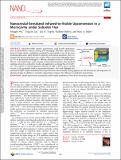| dc.contributor.author | Wu, Mengfei | |
| dc.contributor.author | Lin, Ting-An | |
| dc.contributor.author | Tiepelt, Jan O | |
| dc.contributor.author | Bulović, Vladimir | |
| dc.contributor.author | Baldo, Marc A | |
| dc.date.accessioned | 2022-05-25T18:19:51Z | |
| dc.date.available | 2022-05-25T18:19:51Z | |
| dc.date.issued | 2021 | |
| dc.identifier.uri | https://hdl.handle.net/1721.1/142736 | |
| dc.description.abstract | Infrared-to-visible photon upconversion could benefit applications such as photovoltaics, infrared sensing, and bioimaging. Solid-state upconversion based on triplet exciton annihilation sensitized by nanocrystals is one of the most promising approaches, albeit limited by relatively weak optical absorption. Here, we integrate the upconverting layers into a Fabry-Pérot microcavity with quality factor Q = 75. At the resonant wavelength λ = 980 nm, absorption increases 74-fold and we observe a 227-fold increase in the intensity of upconverted emission. The threshold excitation intensity is reduced by 2 orders of magnitude to a subsolar flux of 13 mW/cm2. We measure an external quantum efficiency of 0.06 ± 0.01% and a 2.2-fold increase in the generation yield of upconverted photons. Our work highlights the potential of triplet-triplet annihilation-based upconversion in low-intensity sensing applications and demonstrates the importance of photonic designs in addition to materials engineering to improve the efficiency of solid-state upconversion. | en_US |
| dc.language.iso | en | |
| dc.publisher | American Chemical Society (ACS) | en_US |
| dc.relation.isversionof | 10.1021/ACS.NANOLETT.0C04060 | en_US |
| dc.rights | Creative Commons Attribution-NonCommercial-NoDerivatives 4.0 International Licens | en_US |
| dc.rights.uri | http://creativecommons.org/licenses/by-nc-nd/4.0/ | en_US |
| dc.source | American Chemical Society | en_US |
| dc.title | Nanocrystal-Sensitized Infrared-to-Visible Upconversion in a Microcavity under Subsolar Flux | en_US |
| dc.type | Article | en_US |
| dc.identifier.citation | Wu, Mengfei, Lin, Ting-An, Tiepelt, Jan O, Bulović, Vladimir and Baldo, Marc A. 2021. "Nanocrystal-Sensitized Infrared-to-Visible Upconversion in a Microcavity under Subsolar Flux." Nano Letters, 21 (2). | |
| dc.contributor.department | Massachusetts Institute of Technology. Department of Electrical Engineering and Computer Science | |
| dc.relation.journal | Nano Letters | en_US |
| dc.eprint.version | Final published version | en_US |
| dc.type.uri | http://purl.org/eprint/type/JournalArticle | en_US |
| eprint.status | http://purl.org/eprint/status/PeerReviewed | en_US |
| dc.date.updated | 2022-05-25T18:05:39Z | |
| dspace.orderedauthors | Wu, M; Lin, T-A; Tiepelt, JO; Bulović, V; Baldo, MA | en_US |
| dspace.date.submission | 2022-05-25T18:05:40Z | |
| mit.journal.volume | 21 | en_US |
| mit.journal.issue | 2 | en_US |
| mit.license | PUBLISHER_CC | |
| mit.metadata.status | Authority Work and Publication Information Needed | en_US |
